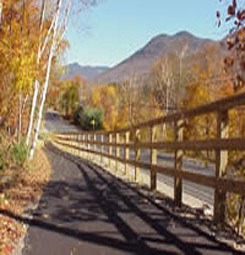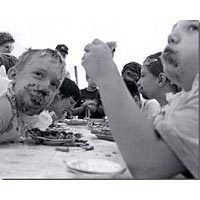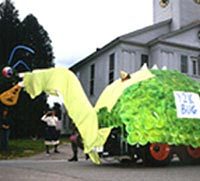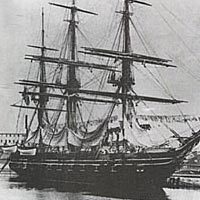
- Capital City:
- Concord
- Nickname:
- Granite State
- Motto:
- Live free or die
- Statehood:
- June 21, 1788 (9th)
- Origin of State's Name:
- Named for Hampshire, England, by Captain John Mason
- Largest Cities:
- Manchester, Nashua, Concord, Derry, Rochester
- Border States:
- Maine, Massachusetts, Vermont
- Land Area:
- 8,969 sq. mi., 44th largest
- State Bird:
- Purple Finch
- State Flower:
- Purple Lilac (syringa vulgaris)
- State Tree:
- White Birch (betula papyrifera)
- State Song:
- Old New Hampshire
One of the original 13 states (it entered the Union in 1788), New Hampshire was named after the English county of Hampshire. New Hampshire is called the "Granite State" because of its numerous granite quarries; the nickname may also reflect the state's attachment to tradition and its history of a frugal government. There are no general sales or individual income taxes, which fits with the state motto of "Live free or die." A relatively small state, New Hampshire plays a major role every four years in the presidential election, as it holds the first primary election. New Hampshire's state bird is the purple finch and its capital is Concord.
Danbury Grange & Community Fair

A celebration of the area's rural heritage, the fair is 85 years old, initiated by the Blazing Star Grange #71. Held each year on the first Saturday after Labor Day, the dawn-to-dusk event features exhibits of produce, flowers, food, and fancywork; an "attic treasures" sale; a horseshoe tournament; a tractor pull; a Dutch auction; storytelling; a baby show; music by the Lyme Town Band; a parade; a street dance; and a ham and bean supper, with a huge variety of pies for desserts. It attracts visitors from all over the state, and beyond. The 1999 parade had as its theme "A Century of Transportation." The Blazing Star Grange will celebrate its 125th anniversary in 2000. It has received state and national recognition for a variety of community service projects.
Hancock Old Home Days

The 1999 Hancock parade may have been small, but its floats were original: a Y2K bug, ridden by members of Hancock's Y2K committee; Chicken Little whose umbrella had computer discs stuck to it, since the sky was falling in bits and bytes; and a "living" painting of a re-enactment of the Iwo Jima flag raising. The historical society's "penny-farthing" bicycle, which has been a parade favorite for 45 years, sported a five-foot tall wheel composed of a garden hose. Other paraders were the Temple Marching Band and the Hancock High School classes of 1954, 1943, and 1938.
The 1999 parade helped mark the 100th anniversary of New Hampshire's Old Home Day, and the 120th celebration for Hancock. Hancock's Old Home Day tradition began as a Symonds family picnic in 1879. Picnics became larger, with attendance reaching 500 in 1884. By 1888, the picnic had become the Hancock Town Picnic. Organizers in 1889 adopted a resolution that the picnic's goal was to encourage sociability and the return of former residents.
Meanwhile, the governor of New Hampshire, Frank Rollins, inaugurated the state's Old Home Day in 1899, and founded the Old Home Day Association. While towns such as Hancock had held annual picnics and "old people's gatherings," Rollins' initiative was new. Invitations were sent across the country inviting relatives and New Hampshire descendants to return to New Hampshire for the statewide celebration. Rollins' goal was to rebuild the state's diminishing population by enticing visitors to buy summer homes and to revitalize community spirit and economy.
Hancock's 1899 Town Picnic was expanded to include an Old Home Week Gathering. Civic-minded poems and ballads were inspired, recited, sung and proclaimed. After 1900, baseball was the only organized activity, with games in the morning and afternoon in between a program of sermons, poems, songs, and reminiscing. In the 1920s, fireworks were added and a special commemoration to mark the arrival of electricity. When Hancock celebrated its 150th anniversary in 1929, more than 10,000 participated, including Mrs. Calvin Coolidge, who had spent her girlhood days in Hancock. She also returned for Hancock's 1938 home day.
History of Portsmouth Naval Shipyard

On June 12, 2000, the Portsmouth Naval Shipyard celebrates its official Bicentennial. Although not formally established until 1800 as a U.S. Navy Yard on New Hampshire's seacoast, Portsmouth has had a reputation for superior shipbuilding for more than 350 years. Captain John Paul Jones himself personally assisted in building the ships he would later command. Many historic ships were built and refurbished for the Navy at Portsmouth, including the USS Raleigh depicted on the New Hampshire State Seal, and the USS Constitution.
Naval ship construction in America had its beginning in 1690 on the shores of the Pisctaqua River, which serves as a natural boundary between Maine and New Hampshire. Though only a few Royal Navy ships were constructed here, colonial building ways were soon controlled by American sympathizers during the revolution, resulting in the construction of at least three U.S. warships. In 1799 chief naval constructor Humphries recommended to the Secretary of the Navy that Portsmouth Harbor be the site of a government owned and operated shipyard -- the swift waters, upriver islands, a ready source of materials and skilled labor being all the reasons he would need to convince Congress to allocate $5,500 for the purchase of the Fernalds Island in Portsmouth Harbor on June 12, 1800.
Through all the major national conflicts, the Portsmouth Naval Shipyard (PNS) was called upon to design and construct warships -- from the War of 1812 to the Vietnam War. "Sails to Atoms" is the shipyard's motto, reflecting its building of the line Washington, launched in 1815, to the fast-attack nuclear submarine USS Sand Lance, launched in 1969. The Shipyard currently has a lead role in the overhaul of nuclear-powered submarines.Through several centuries, the PNS has distinguished itself as a leader in naval design and construction.
Amoskeag Millyard

The largest producer of cotton textiles in the world at the beginning of the 20th century, the Amoskeag Manufacturing Company planned the central city of Manchester and recruited thousands of workers from many different countries. Although the mills closed in 1935, the legacy of the Amoskeag Millyard lives on. The company is largely responsible for the appearance of present-day Manchester as a result of its involvement in city planning; many of the mills are still standing and house a variety of businesses and events. Photographs of these sites are included with a history of the city's development. The diversity of ethnic groups still represented in the city is traceable to the immigration resulting from the Amoskeag worker recruitment program. That history is documented, along with the current cultural activities of Americans of Irish, Greek, Polish, and French-Canadian descent.
 Print
Print Email
Email







